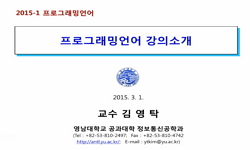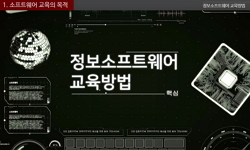스크래치(scratch)는 MIT 미디어랩에서 개발된 세계에서 가장 잘 알려진 비주얼과 블록 기반의 프로그래밍 학습 환경을 제공하는 도구이다. 스크래치는 현재 40개의 언어가 지원되어 150 이상의 ...
http://chineseinput.net/에서 pinyin(병음)방식으로 중국어를 변환할 수 있습니다.
변환된 중국어를 복사하여 사용하시면 됩니다.
- 中文 을 입력하시려면 zhongwen을 입력하시고 space를누르시면됩니다.
- 北京 을 입력하시려면 beijing을 입력하시고 space를 누르시면 됩니다.

스크래치 점자 블록 시스템을 활용한 시각장애 학생들을 위한 프로그래밍 교육 효과 분석 = Effectiveness Analysis of Programming Education for Visually Impaired Students using Scratch Braille Block System
한글로보기https://www.riss.kr/link?id=A107873637
- 저자
- 발행기관
- 학술지명
- 권호사항
-
발행연도
2021
-
작성언어
-
-
주제어
스크래치 ; 점자 ; 소프트웨어 교육 ; 시각장애 학생 ; 프로그래밍 언어 ; Scratch ; Braille ; Software education ; Visually impaired students ; Programming Language
-
등재정보
KCI등재
-
자료형태
학술저널
-
수록면
53-64(12쪽)
-
KCI 피인용횟수
0
- 제공처
-
0
상세조회 -
0
다운로드
부가정보
국문 초록 (Abstract)
시각장애 학생들은 개별 블록 위의 새겨진 점자를 손으로 만지면서 블록의 기능을 인식하고 각각의 블록들을 연결하여 프로그래밍을 할 수 있다. 프로그래밍이 완성된 연결된 블록들의 정보는 스크래치 시뮬레이터에서 결과를 출력한다. 우리는 개발된 스크래치 점자 블록과 스크래치 시뮬레이터를 활용하여 시각 장애학생들에게 스크래치 프로그래밍 수업을 진행하기 위해 수업을 설계하고 적용하는 연구를 진행하였다. 총 5명의 참가자가 수업에 참여하였으며 5명의 참여자 중에서 총 3명이 주어진 4가지의 모든 문제를 완성하였다. 수업을 마친 후에 참가자들은 모두 스크래치 점자 블록 수업에 대해 긍정적으로 평가하였다.
스크래치(scratch)는 MIT 미디어랩에서 개발된 세계에서 가장 잘 알려진 비주얼과 블록 기반의 프로그래밍 학습 환경을 제공하는 도구이다. 스크래치는 현재 40개의 언어가 지원되어 150 이상의 나라에서 사용되고 있다. 비록 스크래치가 누구나 쉽게 접근할 수 있는 환경을 제공하는 등 많은 이점을 갖고 있으나 시각장애인들이 스크래치를 사용하는 데에는 많은 제약이 따른다. 즉, 시각장애인들이 스크래치의 프로그래밍 환경에서 코드를 작성하고 작성한 코드의 결과를 컴퓨터 화면을 통해 경험적으로 학습하는 것은 시각의 제한으로 거의 불가능한 일이다. 따라서 본 논문에서는 시각장애 학생에게 스크래치 프로그래밍을 가르치기 위한 스크래치 점자 블록 시스템의 활용에 대해 소개한다. 스크래치 점자 블록시스템은 점자가 쓰여진 스크래치 점자 블록과 스크래치 시뮬레이터로 구성된다. 스크래치 점자 블록은 스크래치 실물 블록 표면에 스크래치 점자를 추가하여 시각장애 학생이 블록을 인식할 수 있도록 했다. 또한, 스크래치 점자 블록은 스크래치 3.0에서 제공되는 스크래치 블록의 모양과 기능을 동일하게 동작하도록 설계하였다.
시각장애 학생들은 개별 블록 위의 새겨진 점자를 손으로 만지면서 블록의 기능을 인식하고 각각의 블록들을 연결하여 프로그래밍을 할 수 있다. 프로그래밍이 완성된 연결된 블록들의 정보는 스크래치 시뮬레이터에서 결과를 출력한다. 우리는 개발된 스크래치 점자 블록과 스크래치 시뮬레이터를 활용하여 시각 장애학생들에게 스크래치 프로그래밍 수업을 진행하기 위해 수업을 설계하고 적용하는 연구를 진행하였다. 총 5명의 참가자가 수업에 참여하였으며 5명의 참여자 중에서 총 3명이 주어진 4가지의 모든 문제를 완성하였다. 수업을 마친 후에 참가자들은 모두 스크래치 점자 블록 수업에 대해 긍정적으로 평가하였다.
다국어 초록 (Multilingual Abstract)
The visually impaired students can recognize the function of individual block and program each block by touching the engraved braille on the individual blocks with their fingers. The scratch simulator can read the sequences of the connected blocks and run the sprite on the stage. We designed a programming class with the braille blocks and held an experimental class.
We conducted a study designing and applying programming classes using the developed scratch braille block system. A total of five participants participated in the class, and a total of three of the five participants completed all four questions. After class, all participants rated the Scratch Braille Block class as positive.
Scratch is one of the best-known visual, block-based programming languages. Scratch is popular and available in more than 40 languages and 150 countries. Although Scratch makes programming more approachable, it is however very difficult for visually i...
Scratch is one of the best-known visual, block-based programming languages. Scratch is popular and available in more than 40 languages and 150 countries. Although Scratch makes programming more approachable, it is however very difficult for visually impaired people to create code and experience its result in the current Scratch programming environment. In this paper, we introduce a scratch braille block system for teaching scratch programming to visually impaired students. The Scratch Braille block system consists of a set of scratch braille blocks and a scratch simulator. Scratch Braille blocks add braille on top of the individual block to enable visually impaired students to recognize blocks. We also designed scratch braille blocks to mimic the Scratch blocks provided by Scratch 3.0 in terms of their shape and functionality.
The visually impaired students can recognize the function of individual block and program each block by touching the engraved braille on the individual blocks with their fingers. The scratch simulator can read the sequences of the connected blocks and run the sprite on the stage. We designed a programming class with the braille blocks and held an experimental class.
We conducted a study designing and applying programming classes using the developed scratch braille block system. A total of five participants participated in the class, and a total of three of the five participants completed all four questions. After class, all participants rated the Scratch Braille Block class as positive.
참고문헌 (Reference)
1 교육부, "특수교육실태조사" 2017
2 이종호, "통합학급 상황에서 초등학교 장애학생의 진로교육" 한국특수교육문제연구소 19 (19): 47-70, 2018
3 서순식, "초·중등학교에서 성공적인 SW교육 정착을 위한 방안 모색 - 초중등 학생 및 교사의 SW교육에 대한 인식을 중점으로 -" 한국창의정보문화학회 5 (5): 135-143, 2019
4 강경호, "시각장애학교의 중복장애학생 교육 개선을 위한 교사의 경험적 요구" 한국특수아동학회 22 (22): 71-91, 2020
5 이신영, "시각장애학교 중등학생의 진로교육 인식과 실태 연구" 한국특수교육문제연구소 15 (15): 175-198, 2014
6 이태훈, "시각장애학교 맹학생의점자 읽기 유창성에 관한 연구" 한국시각장애교육&재활학회 31 (31): 1-22, 2015
7 김정랑, "발달장애 학생을 위한 로봇 활용 SW교육 프로그램 개발" 한국컴퓨터정보학회 24 (24): 209-216, 2019
8 Tusher Chakraborty, "Towards Devising a Low-cost and Easy-to-use Arithmetic Learning Framework for Economically Less-privileged Visually Impaired Children" 11 (11): 21:1-21:31, 2018
9 Mitchel Resnick, "Scratch : Programming for all" 52 (52): 60-67, 2009
10 Oussama Metatla, "Robots for Inclusive Play: Co-designing an Educational Game With Visually Impaired and sighted Children" 1-13, 2020
1 교육부, "특수교육실태조사" 2017
2 이종호, "통합학급 상황에서 초등학교 장애학생의 진로교육" 한국특수교육문제연구소 19 (19): 47-70, 2018
3 서순식, "초·중등학교에서 성공적인 SW교육 정착을 위한 방안 모색 - 초중등 학생 및 교사의 SW교육에 대한 인식을 중점으로 -" 한국창의정보문화학회 5 (5): 135-143, 2019
4 강경호, "시각장애학교의 중복장애학생 교육 개선을 위한 교사의 경험적 요구" 한국특수아동학회 22 (22): 71-91, 2020
5 이신영, "시각장애학교 중등학생의 진로교육 인식과 실태 연구" 한국특수교육문제연구소 15 (15): 175-198, 2014
6 이태훈, "시각장애학교 맹학생의점자 읽기 유창성에 관한 연구" 한국시각장애교육&재활학회 31 (31): 1-22, 2015
7 김정랑, "발달장애 학생을 위한 로봇 활용 SW교육 프로그램 개발" 한국컴퓨터정보학회 24 (24): 209-216, 2019
8 Tusher Chakraborty, "Towards Devising a Low-cost and Easy-to-use Arithmetic Learning Framework for Economically Less-privileged Visually Impaired Children" 11 (11): 21:1-21:31, 2018
9 Mitchel Resnick, "Scratch : Programming for all" 52 (52): 60-67, 2009
10 Oussama Metatla, "Robots for Inclusive Play: Co-designing an Educational Game With Visually Impaired and sighted Children" 1-13, 2020
11 Peter Fikar, "Pick, Place, And Follow: A Ball Run for Visually Impaired Children" 165-169, 2018
12 Chandimal Jayawardena, "Intelligent Platform for Visually Impaired Children for Learning Indoor and Outdoor Objects" 2019 : 2572-2577, 2019
13 Karen Janette Murcia, "Exploring the multimodality of young children's coding" 34 (34): 1-15, 2019
14 Ana Cristina Pires, "Exploring accessible programming with educators and visually impaired children" 148-160, 2020
15 Diana Franklin, "Eliciting Student Scratch Script Understandings via Scratch Charades" 780-786, 2020
16 Chiara Martolini, "ABBI-K: a novel tool for evaluating spatial and motor abilities in visually impaired children" 1-6, 2018
17 Lala Septem Riza, "A Labyrinth Game for Blind Children Using Problem Solving Learning Model" 15 (15): 58-71, 2020
18 박순희, "4차 산업혁명 시대의 시각장애 교육 방향" 1-10, 2019
19 교육부, "2020 특수교육통계"
동일학술지(권/호) 다른 논문
-
De Moor의 공간추론 개념의 확장과 초등수학교과서의 공간추론 내용의 분석 - 도형영역을 중심으로
- 서울교육대학교 초등교육연구원
- 이정민 ( Lee¸ Jungmin )
- 2021
- KCI등재
-
- 서울교육대학교 초등교육연구원
- 남미주 ( Nam¸ Mijoo )
- 2021
- KCI등재
-
미래형 초등영어 교육과정을 위한 제언: 학습자 맞춤형 교육을 중심으로
- 서울교육대학교 초등교육연구원
- 노경희 ( No¸ Gyeonghee )
- 2021
- KCI등재
-
코로나 19 상황에서 음악 수업 실천 사례 분석을 통한 교사의 수업 역량 탐색
- 서울교육대학교 초등교육연구원
- 김은주 ( Kim¸ Eunju )
- 2021
- KCI등재
분석정보
인용정보 인용지수 설명보기
학술지 이력
| 연월일 | 이력구분 | 이력상세 | 등재구분 |
|---|---|---|---|
| 2022-03-08 | 학회명변경 | 영문명 : Elementary Education Research Center -> Elementary Education Research Institute |  |
| 2022 | 평가예정 | 재인증평가 신청대상 (재인증) | |
| 2019-01-01 | 평가 | 등재학술지 유지 (계속평가) |  |
| 2016-01-01 | 평가 | 등재학술지 선정 (계속평가) |  |
| 2015-01-01 | 평가 | 등재후보학술지 유지 (계속평가) |  |
| 2013-01-01 | 평가 | 등재후보학술지 유지 (기타) |  |
| 2012-01-01 | 평가 | 등재후보학술지 유지 (기타) |  |
| 2011-12-08 | 학술지명변경 | 외국어명 : 미등록 -> Korean Journal of Elementary Education |  |
| 2011-01-01 | 평가 | 등재후보 1차 PASS () |  |
| 2009-01-01 | 평가 | 등재후보학술지 선정 () |  |
| 2007-05-03 | 학회명변경 | 한글명 : 초등교육연구소 -> 초등교육연구원 |
학술지 인용정보
| 기준연도 | WOS-KCI 통합IF(2년) | KCIF(2년) | KCIF(3년) |
|---|---|---|---|
| 2016 | 0.96 | 0.96 | 1.03 |
| KCIF(4년) | KCIF(5년) | 중심성지수(3년) | 즉시성지수 |
| 0.92 | 0.89 | 1.375 | 0.14 |





 KCI
KCI KISS
KISS






